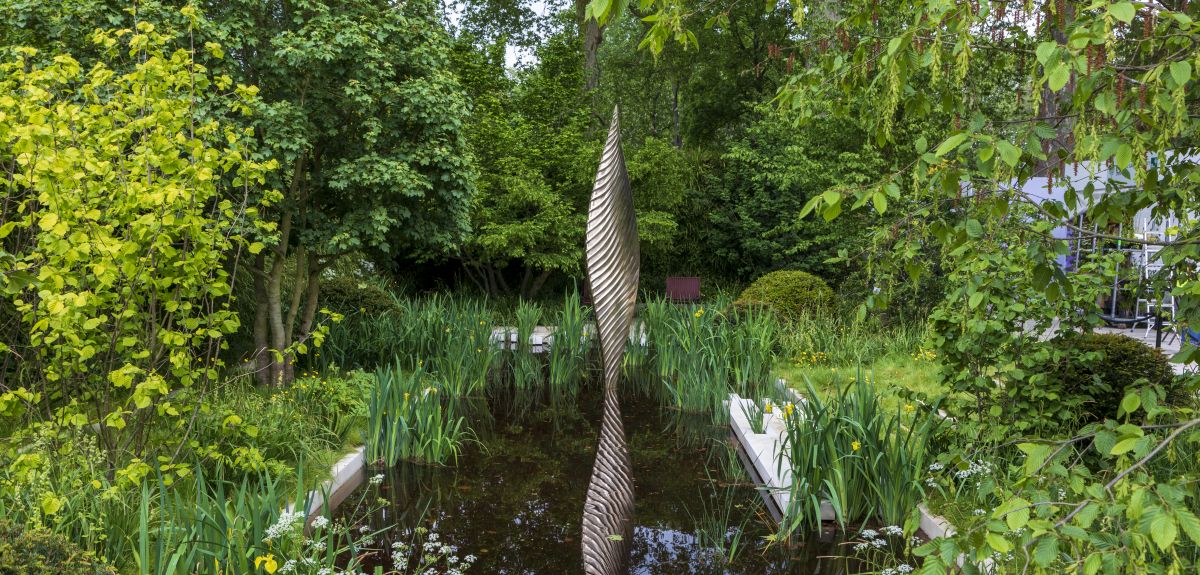
Image credit: Savills and David Harber
Oxford environmentalists support a garden design for human well-being and biodiversity
Environmental scientists at Oxford University have advised celebrated designers in their creation of a garden for this year’s RHS Chelsea Flower show (21-25 May 2019).
The design seeks to create a beautiful, sustainable woodland clearing in a city garden and reflects the importance of keeping green spaces and nature in urban areas. It shows people how a garden can improve their living environment while improving biodiversity.
Dr Pam Berry, Senior Research Fellow at the Environmental Change Institute (ECI) and Geography Fellow (Mansfield College), and Alison Smith, also a researcher at the ECI, worked in collaboration on the garden with Andrew Duff, Managing Director of the Inchbald School of Design, Savills and David Harber garden design.
Urban areas face a number of environmental challenges, such as climate change, pollution, water management, and biodiversity loss, both now and into the future. ECI ecosystems researchers are concerned with the causes and impacts of these environmental changes and in developing management strategies for them, particularly using nature-based solutions.
The garden design seeks to create a beautiful, sustainable woodland clearing in a city garden. It incorporates numerous important elements for addressing environmental challenges including:
- Climate change and reducing air pollution – The garden design features bio-diverse large trees. These can help shade a house in summer, thus reducing temperature and the need air conditioning. Green walls can have the same effect.
- Trees, and to lesser extent green walls, help in reducing air pollution
- Flooding alleviation – Trees, wetland and permeable surfaces all contribute to help moderate water flows, ensuring that water goes into the ground rather than running off directly into drains.
- Water purification – At the heart of the city garden design is a water-purifying wetland area
- Biodiversity - Andrew Duff’s design features roughly 1000 perennial plants and 10,000 bi-annual species, which are predominately native. Flowering plants provide food for pollinators, such as bees, and all features of the garden combine to create a habitat for species, helping reduce biodiversity loss.
Pam Berry explains: ‘While gardens may seem small, if collective action is taken using nature-based solutions we can make a difference to our future living environment, and thus positively impact our own health and well-being. Also, by the careful selection of species, people can help create better conditions for biodiversity too.’
The garden is intended to reflect the beauty and power of nature in every way. It uses a muted green, white and yellow colour palette intended to represent the natural shades of nature and sunlight.
A key feature of the garden is a central pool of water which plays host to a sculptural installation, inspired by the surrounding woodland setting. This unique art work pays homage to the natural calm of its environment with its reflective, textured surface and defiant poise. It mimics and mirrors the trees surrounding it and draws the viewer’s eye to the centre of this living, breathing space - reminding us of the essence and power of nature.
‘By using nature-based solutions and by the careful selection of species people can help create better conditions for biodiversity. All this may not seem much, but gardens, especially if collective action is taken, can make a difference to our future living environment, and thus positively impact our own health and well-being,’ says Pam Berry.
The garden is co-sponsored by global real estate services provider, Savills, and award-winning artist David Harber, whose sculpture will feature as the centerpiece of the garden.
 Expert Comment: Chatbot-driven sexual abuse? The Grok case is just the tip of the iceberg
Expert Comment: Chatbot-driven sexual abuse? The Grok case is just the tip of the iceberg
 New study finds that stopping weight-loss drugs is linked to faster regain than ending diet programmes
New study finds that stopping weight-loss drugs is linked to faster regain than ending diet programmes